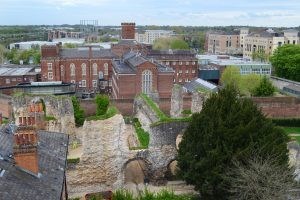
Summit Brings Community Together to Develop Reading Gaol Vision
- A 'Reading Gaol Summit' took place today, bringing together key players from the local community
- Representatives fed in their ideas for a future vision for the vacant prison
THE huge enthusiasm and strength of local support in transforming Reading Gaol into a beacon of arts, heritage and culture was on show again today at a virtual summit, which brought together key players from across the community to develop a long term vision for the vacant site.
Reading Borough Council hosted the Reading Gaol Summit this morning, which was attended by influential representatives from local arts, culture, heritage, business and LGBTQ+ communities, alongside key politicians. The aim was to garner and harness the strength of local community support for the Council’s long term ambition for Reading Gaol, which is to use heritage-led regeneration to create a site of local, regional and national significance sitting within the town’s historic Abbey Quarter.
The Council is exploring the possibility of submitting another bid for the prison site, in partnership with other private sector, voluntary or public organisations. Today’s summit was about collecting views and ideas from participants on a future vision for Reading Gaol. The ideas will feed into a bid that the Council proposes to submit to the Ministry of Justice (MoJ).
Reading Gaol has been empty and unused since December 2013 when it was shut by the MoJ. Following the news last year that the MoJ’s sale of the Reading Prison site had fallen through, the Council has now been granted a period of exclusivity by the MoJ to develop its own bid for the site.
Today’s event featured a presentation by the Council’s Deputy Leader, Councillor Tony Page, on the rich history of the Gaol site, as well as on its context and constraints. The Grade II Listed Prison sits in its entirety on the former footprint of the Reading Abbey complex, a Scheduled Ancient Monument. It was emphasised that any future proposals will need to pay close consideration to the local and national planning policies set out by the Council in the Prison Framework and in its recently adopted Local Plan.
A second presentation, by Giorgio Framalicco, the Council’s Deputy Director of Planning, Transport & Regulatory Services, focused on the development of a detailed vision for the Council’s bid, with the support of communities in Reading.
The final part of the summit saw participants break out into virtual workshops, feeding in their ideas for the Reading Goal vision, which will be used by the Council over the coming weeks as it further develops its bid to the MoJ.
Tony Page, Reading Borough Council’s Lead Councillor for Strategic Environment, Planning and Transport, said:
“Today’s summit was an opportunity for key players from across Reading and beyond to come together with the common goal of developing a future vision for Reading Gaol. This is a bid which will ultimately be submitted by the Council, but we are very clear it is being brought forward on behalf of the Reading community as a whole, and with its full support.
“That community support – which we saw at the Reading Gaol hug back in 2019 – was again on show today. There remains tremendous enthusiasm across all sectors of our community to bring the empty Reading Goal site back to life by creating an arts, heritage and cultural hub of both local and national significance, sitting as it does within our historic Abbey Quarter.
“Our ambition is very clear, but we know that the development of the Reading Gaol site comes with parameters, both in terms of planning constraints designed to protect its historical, archaeological and cultural value, and of course serious financial constraints, in terms of developing a robust business case with external funding streams. This is not something the Council can deliver on its own.
“I would like to thank every single individual who attended today’s summit, both for their interest in securing the future of a potentially superb cultural and heritage asset for Reading and the surrounding area, and for feeding into the development of a future vision for the prison. The Council will now take those ideas away and work on a proposal with a view to submitting it to the MoJ within its current March 15th deadline.”
Notes to editors
Reading Prison – a short history:
The Reading Prison site has considerable historic significance. It formed part of the walled precinct to Reading Abbey and falls within the Reading Abbey and Civil War Earthworks Scheduled Ancient Monument. The site contains a part of the Abbey Church itself and would have contained associated buildings. Part of the site may have been a cemetery associated with the Abbey. There is a high potential for archaeological remains from the Bronze Age through to the period of the Vikings in the 9th Century, as well as the medieval and later interest. The site was an important area in the defence of Reading during the Civil War in 1643.
The prison site also falls within Reading’s Abbey Quarter, which has been the traditional civic and ceremonial heart of the county town of Royal Berkshire since the 12th century. The Quarter is defined by the medieval streets and rivers that outline the precinct of Reading Abbey. This area contains the substantial standing remains and buried archaeology of Reading Abbey, telling its story from the foundation by Henry I in 1121 to its dissolution by Henry VIII in 1539.
The Quarter shows evidence of all periods since the Abbey’s dissolution: a royal residence, civil war defences, Jane Austen’s school, the impressive municipal buildings, Victorian public gardens and Oscar Wilde’s infamous Reading Gaol. There are buildings by famous architects including Sir John Soane, A.W.N. Pugin, Alfred Waterhouse and Sir George Gilbert Scott. Significant public sculpture within the Quarter includes Simond’s Maiwand Lion and statue of Queen Victoria, and contemporary artworks such as the Oscar Wilde Memorial Walk.
Reading Museum is also located within the Quarter and has important collections relating to the heritage of Reading and the Quarter, particularly Reading Abbey and later Victorian industrial heritage. The current Abbey precinct area has piecemeal protection under several local and national designations and policies. Key parts of the site are a Scheduled Ancient Monument, and as such are protected under the provisions of the Ancient Monuments and Archaeological Areas Act 1979; the Abbey Ruins and the Abbey Gate are also Grade I listed.
